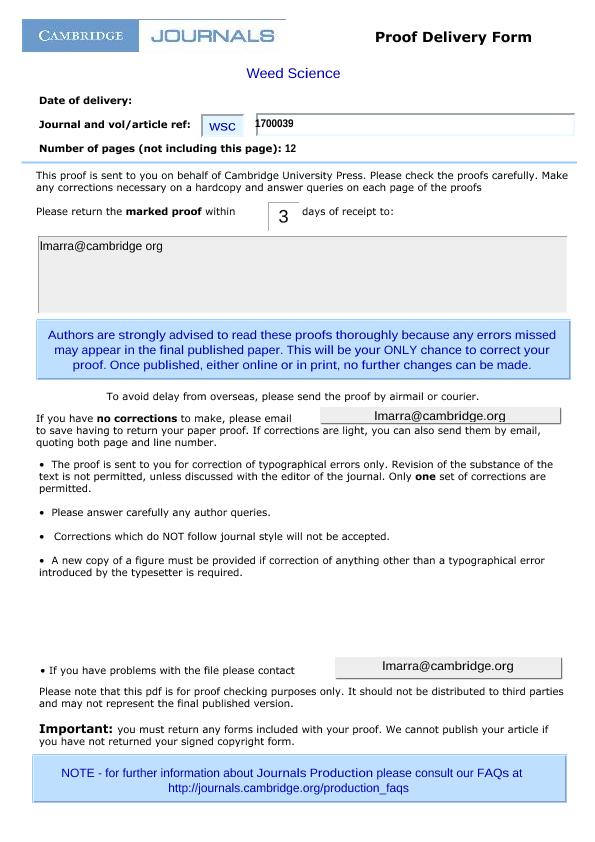Artículo
Multiple-Herbicide Resistance in a 2,4-D - Resistant Waterhemp (Amaranthus tuberculatus) Population from Nebraska
Crespo, Roberto Javier; Wingeyer, Ana Beatriz ; Kruger, Greg R.; Riggins, Chance W.; Tranel, Patrick J.; Bernards, Mark L.
; Kruger, Greg R.; Riggins, Chance W.; Tranel, Patrick J.; Bernards, Mark L.
 ; Kruger, Greg R.; Riggins, Chance W.; Tranel, Patrick J.; Bernards, Mark L.
; Kruger, Greg R.; Riggins, Chance W.; Tranel, Patrick J.; Bernards, Mark L.
Fecha de publicación:
11/2017
Editorial:
Weed Science Society of America
Revista:
Weed Science
ISSN:
0043-1745
Idioma:
Inglés
Tipo de recurso:
Artículo publicado
Clasificación temática:
Resumen
A 2,4-D-resistant tall waterhemp population (FS) from Nebraska was evaluated for resistance to other TIR1 auxin receptor herbicides and to herbicides having alternative mechanisms of action using greenhouse bioassays and genetic markers. Atrazine, imazethapyr, lactofen, mesotrione, glufosinate, and glyphosate were applied in a single-dose bioassay, and tissue was collected from marked plants for genetic analysis. The FS population was not injured by atrazine or by imazethapyr. Approximately 50% of the plants survived lactofen and were actively growing 28 d after treatment. The population was susceptible to mesotrione, glufosinate, and glyphosate. Ametryn, chlorimuron-ethyl, 2,4-D, aminocyclopyraclor, aminopyralid, and picloram were applied in dose - response studies. The FS population was sensitive to ametryn, and the Ser-264-Gly substitution in the D1 protein was not detected, suggesting the lack of response to atrazine is not due to a target-site mutation. The FS population exhibited less than 50% injury to chlorimuron-ethyl at application rates 20 times the labeled use rate. The Ser-653-Asn acetolactate synthase (ALS) substitution, which confers resistance to imidazolinone herbicides, was present in the FS population. However, this does not explain the lack of response to the sulfonylurea herbicide, chlorimuron-ethyl. Sequencing of a portion of the PPX2L gene did not show the ΔG210 mutation that confers resistance to protoporphyrinogen oxidase - inhibiting herbicides, suggesting that other factors were responsible for waterhemp survival after lactofen application. The FS population was confirmed to be at least 30-fold resistant to 2,4-D relative to the susceptible populations. In addition, it was at least 3-fold less sensitive to aminopyralid and picloram, two other TIR1 auxin receptor herbicides, than the 2,4-D-susceptible populations were. These data indicated that the FS population contains both target and non - target site mechanisms conferring resistance to herbicides spanning at least three mechanisms of action: TIR1 auxin receptors, ALS inhibitors, and photosystem II inhibitors.
Palabras clave:
Cross-Resistance
,
Dose - Response
,
Herbicide Resistance
,
Injury
Archivos asociados
Licencia
Identificadores
Colecciones
Articulos(SEDE CENTRAL)
Articulos de SEDE CENTRAL
Articulos de SEDE CENTRAL
Citación
Crespo, Roberto Javier; Wingeyer, Ana Beatriz; Kruger, Greg R.; Riggins, Chance W.; Tranel, Patrick J.; et al.; Multiple-Herbicide Resistance in a 2,4-D - Resistant Waterhemp (Amaranthus tuberculatus) Population from Nebraska; Weed Science Society of America; Weed Science; 65; 6; 11-2017; 743-754
Compartir
Altmétricas



